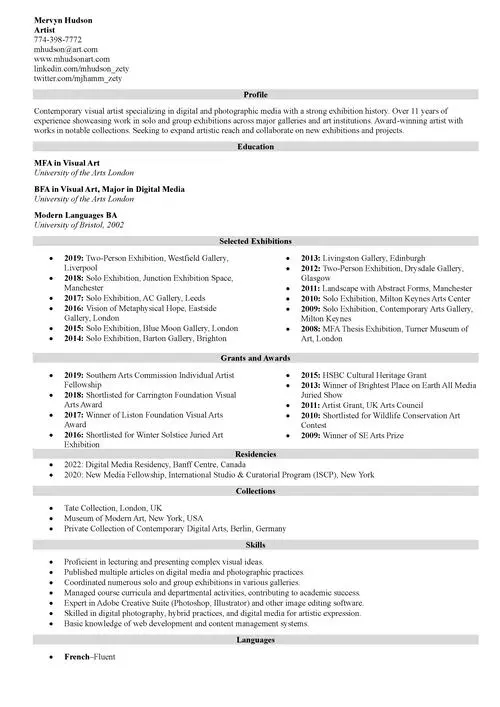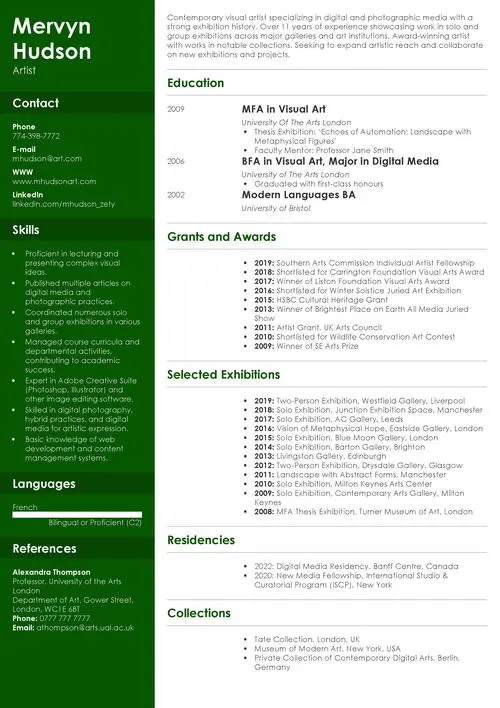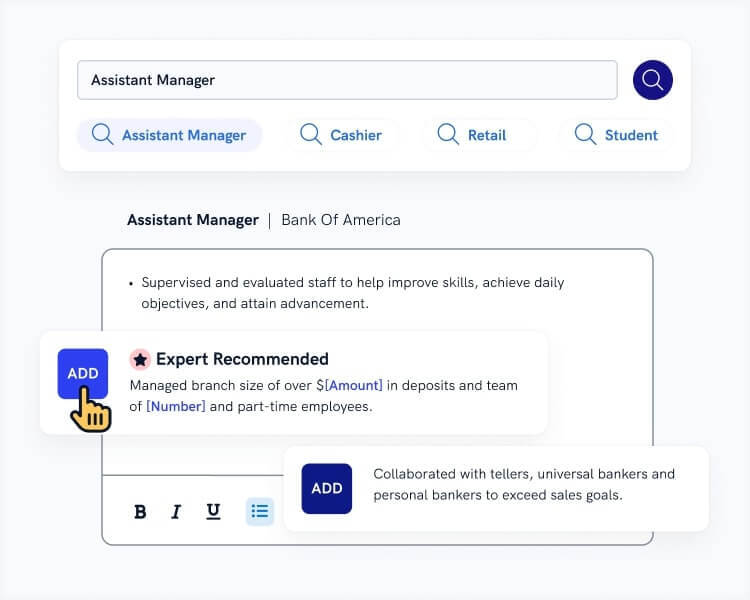Artist CV: Examples & a Ready-to-Use Template [20+ Tips]
Create your CV nowYou’re an artist, and the struggle is real. You need an artist's CV to show alongside your portfolio, and a great art CV can have a more lasting effect than Banksy’s newest piece. Follow this article to learn how to write an artist CV to get your work exhibited, land more work opportunities, and apply for art scholarships.
This guide will show you:
- An artist CV template worthy of the Turner Prize.
- How to write an artist’s CV that selection committees will love.
- The best way to summarise your career and credentials on a CV for artists, with examples.
- How to describe your experience on a curriculum vitae for artists so you can achieve your goals.
Want to save time and have your CV ready in 5 minutes? Try our CV builder. It’s fast and easy to use. Plus, you’ll get ready-made content to add with one click. See 20+ CV templates and create your CV here.
Sample CV made with our builder—See more templates and create your CV here.
One of our users, Nikos, had this to say:
[I used] a nice template I found on Zety. My CV is now one page long, not three. With the same stuff.
Here's an artist CV example made using our CV builder:
Mervyn Hudson
Artist
774-398-7772
mhudson@art.com
www.mhudsonart.com
linkedin.com/mhudson_zety
twitter.com/mjhamm_zety
Profile
Contemporary visual artist specializing in digital and photographic media with a strong exhibition history. Over 11 years of experience showcasing work in solo and group exhibitions across major galleries and art institutions. Award-winning artist with works in notable collections. Seeking to expand artistic reach and collaborate on new exhibitions and projects.
Education
MFA in Visual Art
University of the Arts London
2007–2009
- Thesis Exhibition: ‘Echoes of Automation: Landscape with Metaphysical Figures’
- Faculty Mentor: Professor Jane Smith
BFA in Visual Art, Major in Digital Media
University of the Arts London
2004–2006
- Graduated with first-class honours
Modern Languages BA
University of Bristol, 2002
Selected Exhibitions
- 2019: Two-Person Exhibition, Westfield Gallery, Liverpool
- 2018: Solo Exhibition, Junction Exhibition Space, Manchester
- 2017: Solo Exhibition, AC Gallery, Leeds
- 2016: Vision of Metaphysical Hope, Eastside Gallery, London
- 2015: Solo Exhibition, Blue Moon Gallery, London
- 2014: Solo Exhibition, Barton Gallery, Brighton
- 2013: Livingston Gallery, Edinburgh
- 2012: Two-Person Exhibition, Drysdale Gallery, Glasgow
- 2011: Landscape with Abstract Forms, Manchester
- 2010: Solo Exhibition, Milton Keynes Arts Center
- 2009: Solo Exhibition, Contemporary Arts Gallery, Milton Keynes
- 2008: MFA Thesis Exhibition, Turner Museum of Art, London
Grants and Awards
- 2019: Southern Arts Commission Individual Artist Fellowship
- 2018: Shortlisted for Carrington Foundation Visual Arts Award
- 2017: Winner of Liston Foundation Visual Arts Award
- 2016: Shortlisted for Winter Solstice Juried Art Exhibition
- 2015: HSBC Cultural Heritage Grant
- 2013: Winner of Brightest Place on Earth All Media Juried Show
- 2011: Artist Grant, UK Arts Council
- 2010: Shortlisted for Wildlife Conservation Art Contest
- 2009: Winner of SE Arts Prize
Residencies
- 2022: Digital Media Residency, Banff Centre, Canada
- 2020: New Media Fellowship, International Studio & Curatorial Program (ISCP), New York
Collections
- Tate Collection, London, UK
- Museum of Modern Art, New York, USA
- Private Collection of Contemporary Digital Arts, Berlin, Germany
Skills
- Proficient in lecturing and presenting complex visual ideas.
- Published multiple articles on digital media and photographic practices.
- Coordinated numerous solo and group exhibitions in various galleries.
- Managed course curricula and departmental activities, contributing to academic success.
- Expert in Adobe Creative Suite (Photoshop, Illustrator) and other image editing software.
- Skilled in digital photography, hybrid practices, and digital media for artistic expression.
- Basic knowledge of web development and content management systems.
Languages
- French–Fluent
References
Alexandra Thompson
Professor, University of the Arts London
Department of Art, Gower Street, London, WC1E 6BT
Phone: 0777 777 7777
Email: athompson@arts.ual.ac.uk
This guide covers writing an artist's CV for exhibitions, gallery submissions, and scholarships. If you’re applying to academia, we have a guide with more general advice for writing a CV for academic purposes.
1. Format your artist CV template perfectly
Your CV writing format is the composition: what else is there to say? You know better than I do what aesthetics are all about. In your CV structure, there are a lot of things to cover, so let’s see what they are briefly.
Artist CV templates—section order
- CV header (including your name, phone number, and e-mail address. You might also add a link to your online portfolio, Behance, Instagram, and other relevant platforms)
- CV summary
- Work experience section
- Education section
- Relevant skills
- Additional sections, such as:
- Professional appointments
- Grants and awards
- Exhibitions
- Commissions
- Collections
- Bibliography
- Publications as Author
- Representation
- References
- Languages
- Hobbies and Interests
- Memberships
Looks scarier than what a character in Munch’s painting saw? Don’t worry, I’ll crack it in a minute.
By the way, less experienced artists might not need all of these sections. Feel free to skip any section that isn’t relevant to you or change the order however you please.
What’s more important is to make sure your art CV is easy to follow and understandable even by a layperson. Here’s how:
- Set margins of one inch on each side of the page and line spacing of 1.15. Select double-line spacing between sections to improve the readability of your CV.
- Avoid justification, stick only to the left alignment.
- Start with good CV formatting. Use white space to improve readability and highlight each section of your CV.
- Choose the right CV font. Go for a simple sans serif like Calibri. It’s modern, readable, and renders on most systems.
- Maintain the appropriate length. A one-page CV template is good for an entry-level candidate, but if you have many relevant achievements, your CV might be longer.
- Name your CV appropriately; including your surname and the desired position will suffice.
- Save your CV as a PDF file to keep the correct CV layout. It won’t mess up your careful formatting. But, some employers and institutions will insist you don’t use PDF. Be prepared and save a copy of your artist's CV in another format like DOCX.
So you’ve just seen the full list of the necessary sections for your artist CV and some helpful CV tips. Now, let’s show you how to write each section to highlight your artistic achievements and skills:
Pro tip: As a rule, prioritize the most impressive artistic achievements. If you have an amazing and prestigious bibliography but limited awards, feel free to swap them around.
2. Add a summary to your art CV
Did you know that according to the Ladders, recruiters spend an average of 7.4 seconds reviewing a CV? It’s not that long to impress them with your artistic achievements. That’s where your CV profile comes in handy.
A CV profile can work magic in introducing you to your potential employer, so it's no wonder you should want to exhibit it the most. Including a career summary on your CV for artists will give it that extra little bit of flair and set you apart from the competition. So get drafting!
And bear in mind that:
- Your artist CV profile should summarize the CV that follows. Use it to catch the reader’s eye and keep them reading.
- You need to tailor it to the particular institution and job you’re applying for. No copy-paste laziness here!
In this artist CV sample profile, we’ll discuss a profile written for a lecturer role:
Artist CV sample—profile
| Right |
|---|
| Contemporary visual artist specializing in digital and photographic media with a strong exhibition history. Over 11 years of experience showcasing work in solo and group exhibitions across major galleries and art institutions. Award-winning artist with works in notable collections. Seeking to expand artistic reach and collaborate on new exhibitions and projects. |
| Wrong |
|---|
| Skilled lecturer seeking a position as a Photography Lecturer at the University of Liverpool. Accomplished professional photographer dedicated to inspiring the next generation. Possesses strong interpersonal skills and a talent for fostering creativity and open-mindedness in an academic environment. |
The first artist CV profile is meticulously tailored for a specific role, highlighting the applicant's specialized expertise. It underscores their status as an active artist, incorporates key performance metrics, and mentions winning a prestigious award.
The second example doesn’t deliver any details. Guess which one’s more impressive.
Pro tip: For a standard CV for a jobbing artist we’d say, yes, absolutely include a profile. For an academic artist's CV, though, a profile is not always 100% in line with academic standards.
When making a CV in our builder, drag & drop bullet points, skills, and auto-fill the boring stuff. Spell check? Check. Start building a professional CV template here for free.
When you’re done, Zety’s CV builder will score your CV and tell you exactly how to make it better.
3. Create a strong education section on your artist CV example
Your educational journey is the cornerstone of your artistic development. This section isn't just a list of degrees; it's a narrative that showcases the academic experiences that have shaped your creative vision. That’s why it has to be done perfectly.
Here’s how to create a great education section on your artist CV:
- Start off by making a list of your degrees.
- Arrange them in reverse chronological order.
- Include:
- Year of completion (or expected graduation if you’re still studying)
- Type of your degree
- Department and institution
- Honours
- Thesis title and advisor
Here’s a sample:
Artist CV example—education section
Education
MFA in Visual Art
University of the Arts London
2007–2009
- Thesis Exhibition: ‘Echoes of Automation: Landscape with Metaphysical Figures’
- Faculty Mentor: Professor Jane Smith
BFA in Visual Art, Major in Digital Media
University of the Arts London
2004–2006
- Graduated with first-class honours
Modern Languages BA
University of Bristol, 2002
That’s exactly how to do it right. Thesis, honors and the right format. Stunning.
Pro Tip: Be precise with your academic title. There are important differences between associate professor, assistant professor, lecturer and so on. If the school doesn’t use ranks and distinctions, you can use ‘faculty’ instead.
4. Show your achievements on an artist's CV
Did you know there were approximately 43,600 people employed as artists in the UK? You know there are even more artists if you’ve visited Camden Town at least once. No matter the exact number, your CV still needs to stand out among others.
Here’s how to showcase your experience on an artist's CV:
- Organize your artistic achievements in reverse chronological order, starting with the most recent.
- List exhibitions, residencies, grants, and collections as separate sections to highlight your career progression.
- When listing exhibitions, include the title, year, venue, and location, noting whether they were solo or group exhibitions.
- For residencies, state the year, program name, and location, emphasizing prestigious or internationally recognized programs.
- When mentioning grants and awards, include the name, awarding body, and year, highlighting competitive or high-profile achievements.
- If your work is in notable public or private collections, list institutions or collectors to establish credibility.
- Use action-driven descriptions to emphasize impact, e.g., “Awarded the Pollock-Krasner Foundation Grant for innovative use of digital media” or “Exhibited at MoMA as part of the ‘New Media Visions’ exhibition.”
- Ensure your CV is tailored to the opportunity you're applying for, prioritizing achievements that best align with the role or exhibition.
By structuring your artist CV this way, you’ll present a strong professional narrative that highlights your artistic success and recognition.
Let’s take a closer look at two samples:
Artist CV examples—work experience section
| Right |
|---|
Selected Exhibitions
Grants and Awards
Residencies
Collections
|
| Wrong |
|---|
Selected Exhibitions
Grants and Awards
Residencies
Collections
|
The first example is relevant and impressive. The second one is vague, lacks structure, and provides no specific details, making it difficult to assess the artist’s accomplishments. It fails to include dates, locations, exhibition titles, and awarding bodies, which are all essential for an artist's CV.
Find out what should your recruiter find in your work experience section: What to include in a CV experience section
5. Add impressive skills to your artist CV
The skills section is where your talents truly shine. It's more than just a list of abilities; it's a testament to your proficiency and versatility as an artist. Highlight both your technical skills, such as proficiency in various mediums and software, and your soft skills, like creativity, collaboration, and problem-solving.
Here’s how to create a good skills section for your artist CV:
- Revisit the job offer.
- List every mentioned skill.
- Create a second list of all of your skills.
- Select 5–10 skills that align with the job requirements.
- Include them in your skills section.
Let’s see an example of a properly made skills section on an artist's CV:
Artist CV example—skills section
Skills
- Proficient in lecturing and presenting complex visual ideas.
- Published multiple articles on digital media and photographic practices.
- Coordinated numerous solo and group exhibitions in various galleries.
- Managed course curricula and departmental activities, contributing to academic success.
- Expert in Adobe Creative Suite (Photoshop, Illustrator) and other image editing software.
- Skilled in digital photography, hybrid practices, and digital media for artistic expression.
- Basic knowledge of web development and content management systems.
All are listed in a readable way, and no further explanation is required. Perfect.
This concludes all the necessary parts of any CV. Let’s move on to additional sections.
For more ideas about what to add, check out our expert guide: What to Include in a CV: Must-Have CV Sections
Include a cover letter to your artist CV
By now, you’ll have a well-crafted artist CV. But there's one more step to make your application shine more than Jeff Koons' Baloon Dogs: a cover letter. This will elevate your CV and make a strong impression.
Here’s how to write a great cover letter for artist roles:
- Format your cover letter, ensuring a good structure and proper address.
- Start your cover letter correctly with a ‘hook’ and highlight a key achievement.
- Detail relevant experience and accomplishments, showing passion for the role.
- End your cover letterwith a request for further discussion.
- Stick to the right cover letter length, limiting it to one page.
Et voila! Your new masterpiece called “My job-winning artistic CV” is ready to be exhibit to the world. Go on and show it.
Plus, a great cover letter that matches your CV will give you an advantage over other candidates. You can write it in our cover letter builder here. Here's what it may look like:
See more cover letter templates and start writing.
Key Takeaway
The arts field is fiercely competitive, leaving no room for complacency when crafting an artist CV. Transform your artist CV into a masterpiece with these tips:
- Maintain a clear and consistent structure and formatting.
- Write an artist CV profile to distinguish you from your competitors.
- Explain your work experience and education in separate sections.
- Add your most relevant skills.
- Showcase your talent by listing awards, exhibitions, commissions, collections, and bibliographies.
- Boost your chances of getting hired by adding a compelling cover letter.
And that’s it.
About Zety’s Editorial Processs
Our editorial team has thoroughly reviewed this article to ensure it follows Zety’s editorial guidelines. Our dedication lies in sharing our expertise and providing you with actionable career advice that offers you real value. Every year, the quality of our content attracts 40 million readers to our site. But that’s not all – we conduct original research to gain a detailed understanding of the labour market. We take pride in being cited by top universities and leading media outlets in the UK and worldwide.







